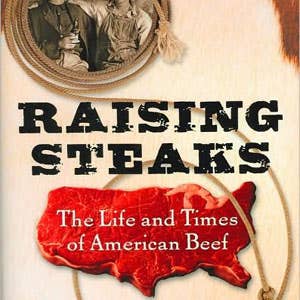
Sacred Cows
The past few years have seen a spate of books centered on the histories of single foods: salt, chocolate, chiles, and so on—books that invite readers to "see a world in a grain of sand", to quote the poet William Blake. Having relished a few of these volumes but struggled through many others, I greeted two of the genre's latest exemplars—one on milk, the other on beef—with a skeptic's eye. Then I started reading. And I kept reading.
I began with Milk: The Surprising Story of Milk Through the Ages (Knopf, $29.95) by the veteran food writer Anne Mendelson. Part historical epic, part cookbook, and part memoir, Milk brims with the enthusiasm of a genuine food devotee. "[T]he impetus behind this book," the author writes in her introduction, "was my eagerness to share the voyages of culinary discovery.... What I learned, in a nutshell, is that the usual American ways with milk and dairy products are only a narrow, anomalous sidetrack from something immensely larger, richer, and more ancient." Mendelson succeeds in her mission, taking readers on a journey that begins with the bold moment when man first decided to consume the milk of other animals and following the herds of sheep, goats, and cows across centuries and continents.
What's more, Milk accomplishes what only the best single-food histories, like Mark Kurlansky's Cod (Penguin, 1998) and Salt (Walker & Co., 2002), have done: it makes the reader see what they eat in an entirely new light. Like a culinary cartographer, Mendelson redraws borders, coining sociogeographic terms that highlight the fascinating ways human beings use dairy products. She dubs the Near East, where brined cheeses, yogurts, and the fermented milk of goats, sheep, and cows figure prominently, the "Diverse Sources Belt"; a swath of the globe encompassing the Indian subcontinent is referred to as "Yogurtistan"; and most of Europe and North America falls within the "Northwestern Cow Belt". The sweep of the narrative is anchored by a wealth of practical features, including an authoritative glossary and, most notably, recipes. There are 120 of them, for everything from Bulgarian cold yogurt soup to clotted cream. And while Mendelson doesn't shy away from such thorny issues as industrial farming and pasteurization, I finished her book feeling refreshed and enlightened.
The second of the two volumes I recently read, Raising Steaks: The Life and Times of American Beef (Harcourt, $26) by the preeminent culinary historian Betty Fussell, confines itself to American shores, but the scope of the research is no less impressive. Fussell's book, the result of three years' worth of firsthand reporting, is not the only tome on the history of American beef to have been published recently (others include Beef: The Untold Story of How Milk, Meat, and Muscle Shaped the World by Andrew Rimas and Evan Fraser; William Morrow, 2008), but it is surely the most thorough. The author's subject comes the most vividly alive in the moments when she documents the real-life people and places that fuel the American ardor for red meat. She attends a stock show in Colorado Springs; tours the bloody floor of a meat-processing plant in Fort Dodge, Kansas; sits in on a Beef 101 class at Texas A&M's Department of Animal Science; roams grassland prairies to discover the benefits of "green" ranching; and attends an auction in Florida to get a glimpse of the endangered Pineywoods longhorn cattle.
As with Mendelson's book, the author is a player in her expansive drama, guided by an admittedly romantic attachment to the American West. Indeed, given its cast of cowboys, ranchers, and other American archetypes, Raising Steaks could easily have veered into the realm of cliche, but Fussell is too nuanced and engaging a writer to have let that happen. Her adventurous spirit is contagious, as is her unabashed pleasure in details, like the architectural principles of a Stetson hat and the existence of a 19th-century cow tunnel beneath the streets of New York City.
Though she ably addresses unpalatable topics like mad cow disease and animal cruelty, the author's affection for steak—the king of the American dinner table, a symbol that unites our country's pastoral past with its industrialized present—is never dampened. I haven't ever seen that food summed up more beautifully than in Fussell's words: "It's the closest we can get to yoking the raw and the cooked, the savage and the civilized."
Keep Reading
Continue to Next Story










